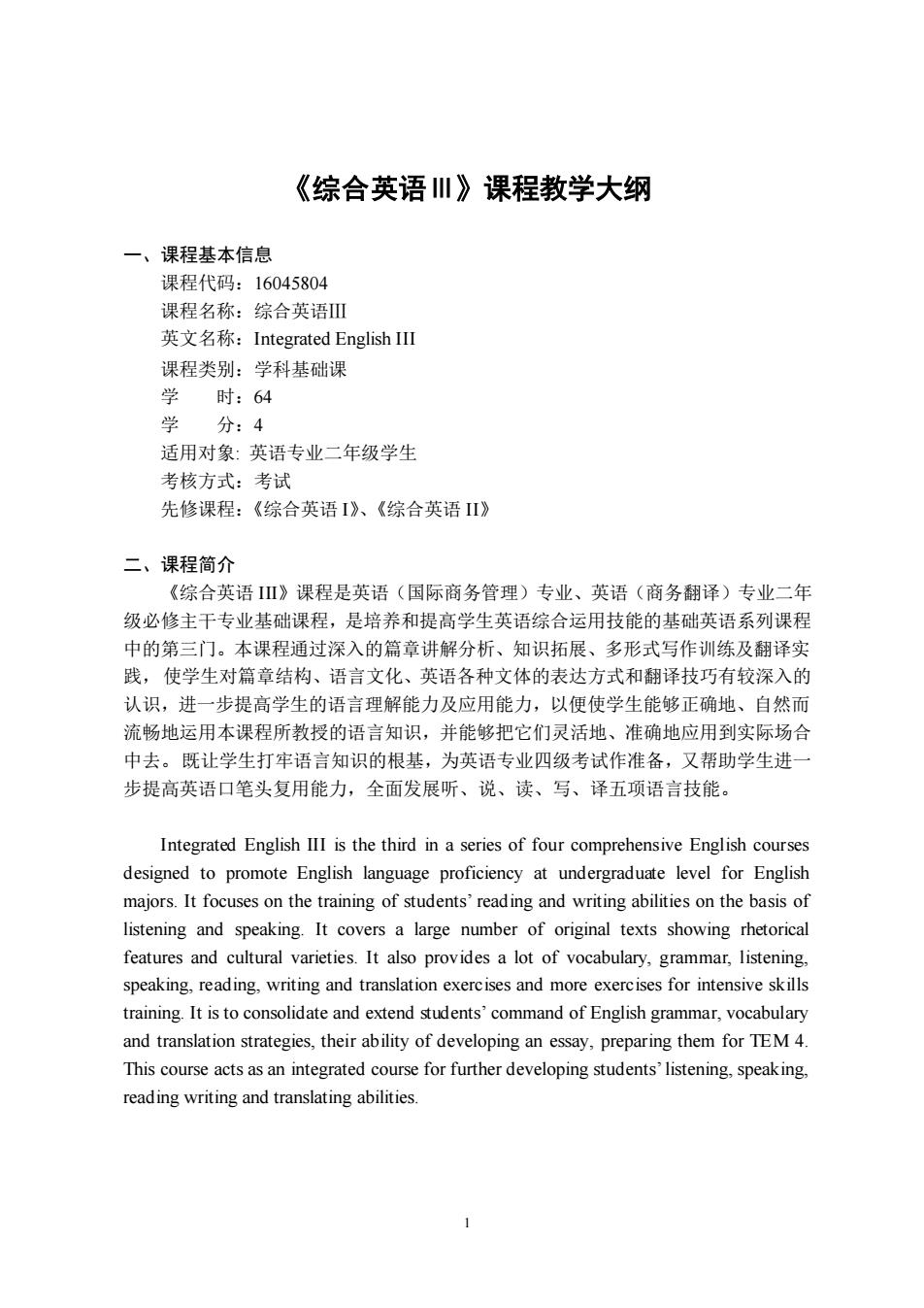
《综合英语川》课程教学大纲 一、课程基本信息 课程代码:16045804 课程名称:综合英语I 英文名称:Integrated EnglishⅢ 课程类别:学科基础课 学 时:64 学 分:4 适用对象:英语专业二年级学生 老核方式:老试 先修课程:《综合英语I》、《综合英语Ⅱ》 二、课程简介 《综合英语Ⅲ》课程是英语(国际商务管理)专业、英语(商务翻译)专业二年 级必修主干专业基础课程,是培养和提高学生英语综合运用技能的基础英语系列课程 中的第三门。本课程通过深入的篇章讲解分析、知识拓展、多形式写作训练及翻译实 践,使学生对篇章结构、语言文化、英语各种文体的表达方式和翻译技巧有较深入的 认识,进一步提高学生的语言理解能力及应用能力,以便使学生能够正确地、自然而 流畅地运用本课程所教授的语言知识,并能够把它们灵活地、准确地应用到实际场合 中去。既让学生打牢语言知识的根基,为英语专业四级考试作准备,又帮助学生进 步提高英语口笔头复用能力,全面发展听、说、读、写、译五项语言技能。 Integrated English III is the third in a series of four comprehensive English courses designed to promote English language proficiency at undergraduate level for English maiors.It focuses on the training of students'reading and writing abilities on the basis of listening and speaking.It covers a large number of original texts showing rhetorical features and cultural varieties.It also provides a lot of vocabulary,grammar,listening. speaking.reading.writing and translation exercises and more exercises for intensive skills training.It is to consolidate and extend students'command of English grammar,vocabulary and translation strategies,their ability of developing an essay,preparing them for TEM 4. This course acts as an integrated course for further developing students'listening.speaking. read ing writing and translating abilities
1 《综合英语Ⅲ》课程教学大纲 一、课程基本信息 课程代码:16045804 课程名称:综合英语Ⅲ 英文名称:Integrated English III 课程类别:学科基础课 学 时:64 学 分:4 适用对象: 英语专业二年级学生 考核方式:考试 先修课程:《综合英语 I》、《综合英语 II》 二、课程简介 《综合英语 III》课程是英语(国际商务管理)专业、英语(商务翻译)专业二年 级必修主干专业基础课程,是培养和提高学生英语综合运用技能的基础英语系列课程 中的第三门。本课程通过深入的篇章讲解分析、知识拓展、多形式写作训练及翻译实 践,使学生对篇章结构、语言文化、英语各种文体的表达方式和翻译技巧有较深入的 认识,进一步提高学生的语言理解能力及应用能力,以便使学生能够正确地、自然而 流畅地运用本课程所教授的语言知识,并能够把它们灵活地、准确地应用到实际场合 中去。既让学生打牢语言知识的根基,为英语专业四级考试作准备,又帮助学生进一 步提高英语口笔头复用能力,全面发展听、说、读、写、译五项语言技能。 Integrated English III is the third in a series of four comprehensive English courses designed to promote English language proficiency at undergraduate level for English majors. It focuses on the training of students’ reading and writing abilities on the basis of listening and speaking. It covers a large number of original texts showing rhetorical features and cultural varieties. It also provides a lot of vocabulary, grammar, listening, speaking, reading, writing and translation exercises and more exercises for intensive skills training. It is to consolidate and extend students’ command of English grammar, vocabulary and translation strategies, their ability of developing an essay, preparing them for TEM 4. This course acts as an integrated course for further developing students’ listening, speaking, reading writing and translating abilities
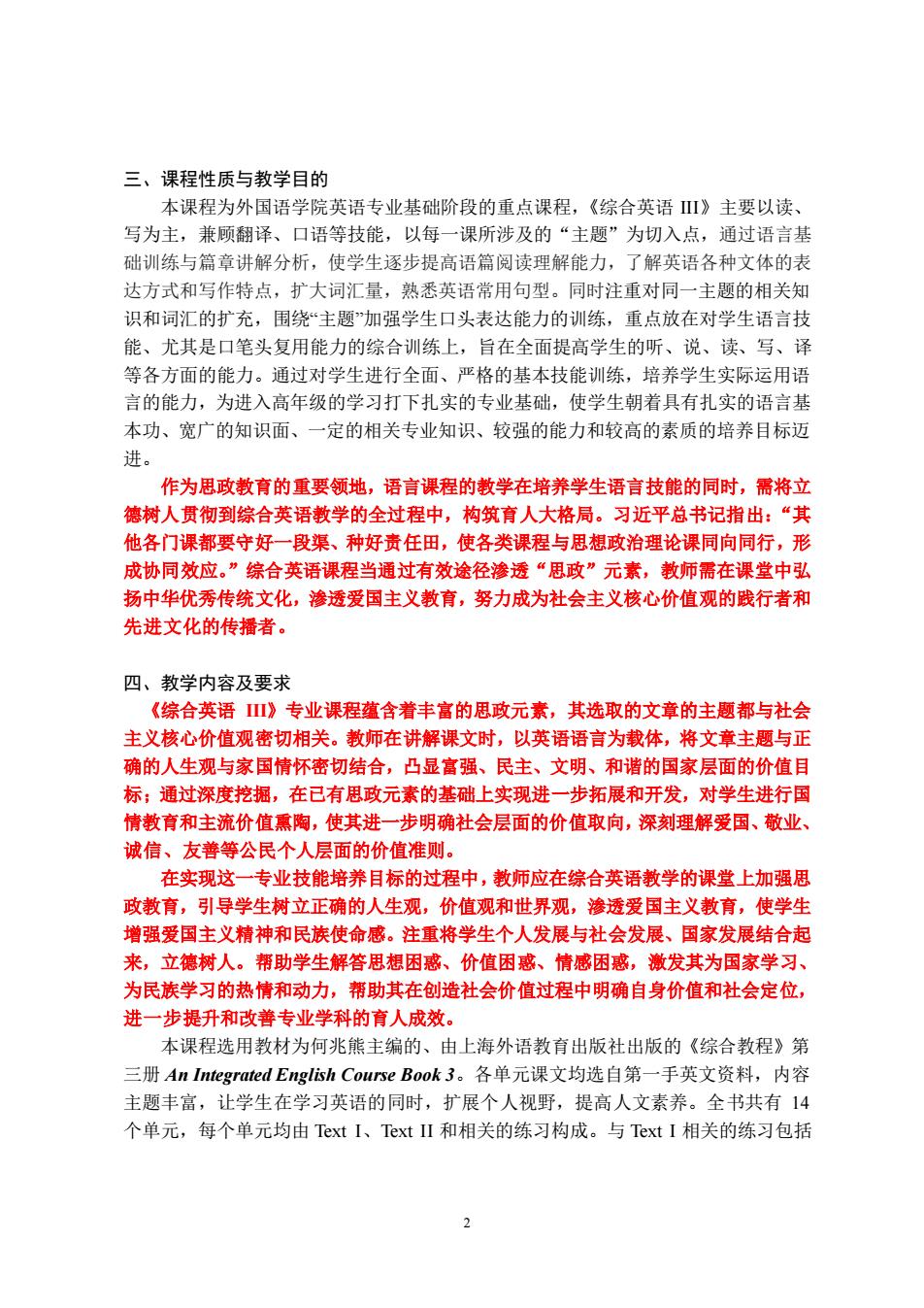
三、课程性质与教学目的 本课程为外国语学院英语专业基础阶段的重点课程,《综合英语Ⅲ》主要以读 写为主,兼顾翻译、口语等技能,以每一课所涉及的“主题”为切入点,通过语言基 础训练与篇章讲解分析,使学生逐步提高语篇阅读理解能力,了解英语各种文体的表 达方式和写作特点,扩大词汇量,熟悉英语常用句型。同时注重对同一主题的相关知 识和词汇的扩充,围绕“主题加强学生口头表达能力的训练,重点放在对学生语言技 能、广其是口笔头复用能力的综合训练上,后在全面提高学生的听、说、读、写、译 等各方面的能力。通过对学生进行全面、严格的基本技能训练,培养学生实际运用语 言的能力,为讲入高年级的学习打下H实的专业基础,使学生朝着具有引实的语言其 本功、宽广的知识面、一定的相关专业知识、较强的能力和较高的素质的培养目标迈 作为思政教育的重要领地,语言课程的教学在培养学生语言技能的同时,需将立 德树人贯彻到综合英语教学的全过程中,构筑育人大格局。习近平总书记指出:“其 他各门课都要守好一段渠、种好责任田,使各类课程与思想政治理论课同向同行,形 成协同效应。”综合英语课程当通过有效途径渗透“思政”元素,教师需在课堂中弘 扬中华优秀传统文化,渗透爱国主义教育,努力成为社会主义核心价值观的践行者和 先进文化的传播者。 四、教学内容及要求 《综合英语》专业课程蕴含着丰富的思政元素,其选取的文章的主题都与社会 主义核心价值观密切相关。教师在讲解课文时,以英语语言为载体,将文章主题与正 确的人生观与家国情怀密切结合,凸显富强、民主、文明、和谐的国家层面的价值目 标:通过深度挖掘,在已有思政元素的基础上实现进一步拓展和开发,对学生进行国 情教育和主流价值熏陶,使其进一步明确社会层面的价值取向,深刻理解爱国、散业、 诚信、友善等公民个人层面的价值准则。 在实现这一专业技能培养目标的过程中,教师应在综合英语教学的课堂上加强思 政教育,引导学生树立正确的人生观,价值观和世界观,渗透爱国主义教育,使学生 增强爱国主义精神和民族使命感。注重将学生个人发展与杜会发展、国家发展结合起 来,立德树人。帮助学生解答思想困惑、价值困惑、情感困惑,激发其为国家学习、 为民族学习的热情和动力,蒂助其在创造社会价值过程中明确自身价值和社会定位, 进一步提升和改善专业学科的育人成效。 本课程选用教材为何兆熊主编的、由上海外语教育出版社出版的《综合教程》第 三册An Integrated English Course Book3。各单元课文均选自第一手英文资料,内容 主题丰富,让学生在学习英语的同时,扩展个人视野,提高人文素养。全书共有14 个单元,每个单元均由Text I、TextⅡ和相关的练习构成。与Text I相关的练习包括 2
2 三、课程性质与教学目的 本课程为外国语学院英语专业基础阶段的重点课程,《综合英语 III》主要以读、 写为主,兼顾翻译、口语等技能,以每一课所涉及的“主题”为切入点,通过语言基 础训练与篇章讲解分析,使学生逐步提高语篇阅读理解能力,了解英语各种文体的表 达方式和写作特点,扩大词汇量,熟悉英语常用句型。同时注重对同一主题的相关知 识和词汇的扩充,围绕“主题”加强学生口头表达能力的训练,重点放在对学生语言技 能、尤其是口笔头复用能力的综合训练上,旨在全面提高学生的听、说、读、写、译 等各方面的能力。通过对学生进行全面、严格的基本技能训练,培养学生实际运用语 言的能力,为进入高年级的学习打下扎实的专业基础,使学生朝着具有扎实的语言基 本功、宽广的知识面、一定的相关专业知识、较强的能力和较高的素质的培养目标迈 进。 作为思政教育的重要领地,语言课程的教学在培养学生语言技能的同时,需将立 德树人贯彻到综合英语教学的全过程中,构筑育人大格局。习近平总书记指出:“其 他各门课都要守好一段渠、种好责任田,使各类课程与思想政治理论课同向同行,形 成协同效应。”综合英语课程当通过有效途径渗透“思政”元素,教师需在课堂中弘 扬中华优秀传统文化,渗透爱国主义教育,努力成为社会主义核心价值观的践行者和 先进文化的传播者。 四、教学内容及要求 《综合英语 III》专业课程蕴含着丰富的思政元素,其选取的文章的主题都与社会 主义核心价值观密切相关。教师在讲解课文时,以英语语言为载体,将文章主题与正 确的人生观与家国情怀密切结合,凸显富强、民主、文明、和谐的国家层面的价值目 标;通过深度挖掘,在已有思政元素的基础上实现进一步拓展和开发,对学生进行国 情教育和主流价值熏陶,使其进一步明确社会层面的价值取向,深刻理解爱国、敬业、 诚信、友善等公民个人层面的价值准则。 在实现这一专业技能培养目标的过程中,教师应在综合英语教学的课堂上加强思 政教育,引导学生树立正确的人生观,价值观和世界观,渗透爱国主义教育,使学生 增强爱国主义精神和民族使命感。注重将学生个人发展与社会发展、国家发展结合起 来,立德树人。帮助学生解答思想困惑、价值困惑、情感困惑,激发其为国家学习、 为民族学习的热情和动力,帮助其在创造社会价值过程中明确自身价值和社会定位, 进一步提升和改善专业学科的育人成效。 本课程选用教材为何兆熊主编的、由上海外语教育出版社出版的《综合教程》第 三册 An Integrated English Course Book 3。各单元课文均选自第一手英文资料,内容 主题丰富,让学生在学习英语的同时,扩展个人视野,提高人文素养。全书共有 14 个单元,每个单元均由 Text I、Text II 和相关的练习构成。与 Text I 相关的练习包括
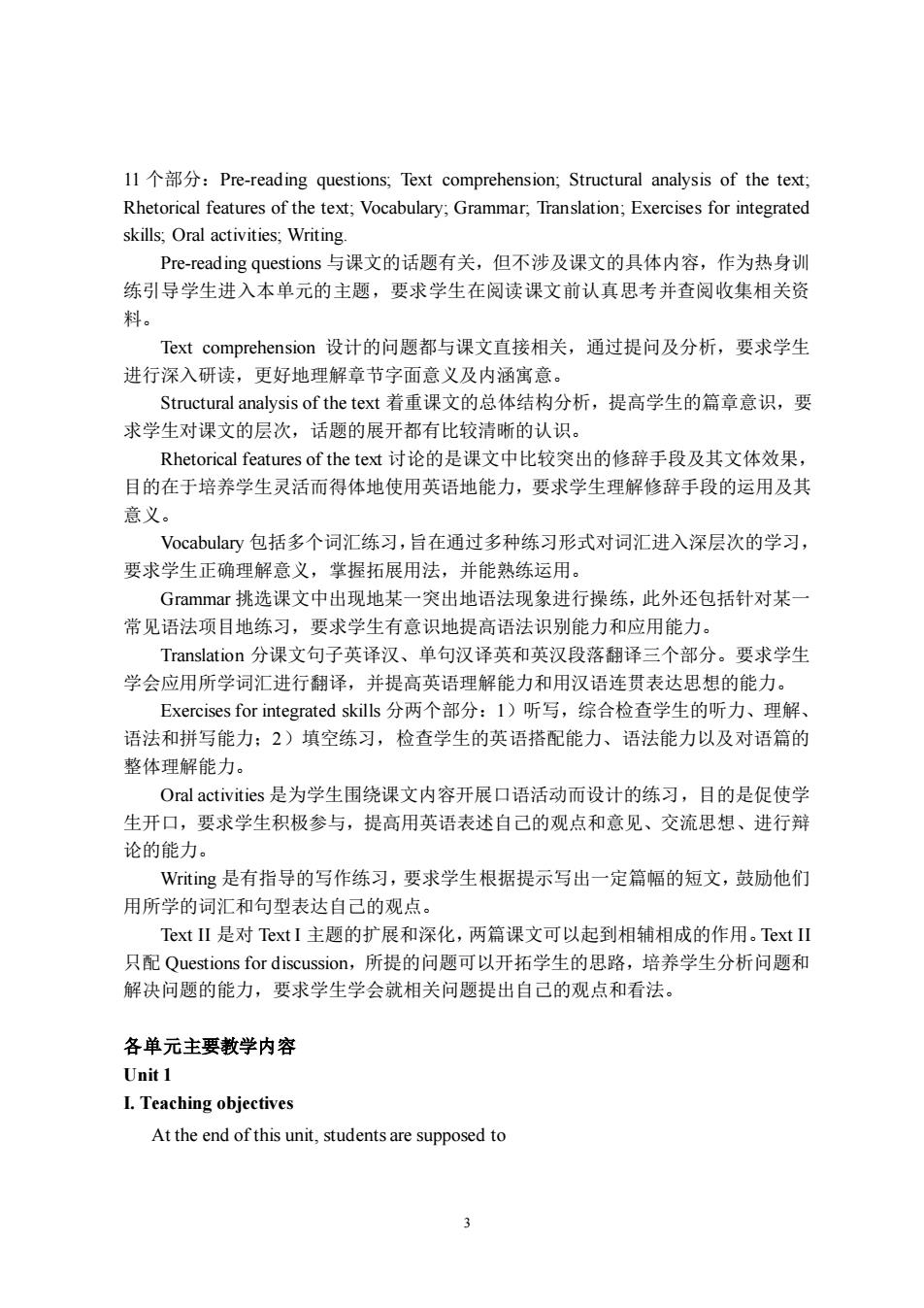
Il个a部分:Pre-reading questions,Text comprehension;Structural analysis of the text; Rhetorical features of the text,Vocabulary:Grammar,Translation;Exercises for integrated skills;Oral activities;Writing. Pre--reading questions与课文的话题有关,但不涉及课文的具体内容,作为热身训 练引导学生进入本单元的主题,要求学生在阅读课文前认真思考并查阅收集相关资 料。 Text comprehension设计的问题都与课文直接相关,通过提问及分析,要求学生 进行深入研读,更好地理解章节字面意义及内涵寓意。 Structural analysis of the text着重课文的总体结构分析,提高学生的篇章意识,要 求学生对课文的层次,话题的展开都有比较清晰的认识。 Rhetorical features of the text讨论的是课文中比较突出的修辞手段及其文体效果, 目的在于培养学生灵活而得体地使用英语地能力,要求学生理解修辞手段的运用及其 意义。 Vocabulary包括多个词汇练习,旨在通过多种练习形式对词汇进入深层次的学习, 要求学生正确理解意义,掌握拓展用法,并能熟练运用。 Grammar挑选课文中出现地某一突出地语法现象进行操练,此外还包括针对某一 常见语法项目地练习,要求学生有意识地提高语法识别能力和应用能力。 Translation分课文句子英译汉、单句汉译英和英汉段落翻译三个部分。要求学生 学会应用所学词汇进行翻译,并提高英语理解能力和用汉语连贯表达思想的能力。 Exercises for integrated skills分两个部分:I)听写,综合检查学生的听力、理解、 语法和拼写能力:2)填空练习,检查学生的英语搭配能力、语法能力以及对语篇的 整体理解能力。 Oral activities是为学生围绕课文内容开展口语活动而设计的练习,目的是促使学 生开口,要求学生积极参与,提高用英语表述自己的观点和意见、交流思想、进行辩 论的能力。 Writing是有指导的写作练习,要求学生根据提示写出一定篇幅的短文,鼓励他们 用所学的词汇和句型表达自己的观点。 Text IⅡ是对TextI主题的扩展和深化,两篇课文可以起到相辅相成的作用。TextIⅡ 只配Questions for discussion,所提的问题可以开拓学生的思路,培养学生分析问题和 解决问题的能力,要求学生学会就相关问题提出自己的观点和看法。 各单元主要教学内容 Unit 1 I.Teaching objectives At the end of this unit,students are supposed to 3
3 11 个部分:Pre-reading questions; Text comprehension; Structural analysis of the text; Rhetorical features of the text; Vocabulary; Grammar; Translation; Exercises for integrated skills; Oral activities; Writing. Pre-reading questions 与课文的话题有关,但不涉及课文的具体内容,作为热身训 练引导学生进入本单元的主题,要求学生在阅读课文前认真思考并查阅收集相关资 料。 Text comprehension 设计的问题都与课文直接相关,通过提问及分析,要求学生 进行深入研读,更好地理解章节字面意义及内涵寓意。 Structural analysis of the text 着重课文的总体结构分析,提高学生的篇章意识,要 求学生对课文的层次,话题的展开都有比较清晰的认识。 Rhetorical features of the text 讨论的是课文中比较突出的修辞手段及其文体效果, 目的在于培养学生灵活而得体地使用英语地能力,要求学生理解修辞手段的运用及其 意义。 Vocabulary 包括多个词汇练习,旨在通过多种练习形式对词汇进入深层次的学习, 要求学生正确理解意义,掌握拓展用法,并能熟练运用。 Grammar 挑选课文中出现地某一突出地语法现象进行操练,此外还包括针对某一 常见语法项目地练习,要求学生有意识地提高语法识别能力和应用能力。 Translation 分课文句子英译汉、单句汉译英和英汉段落翻译三个部分。要求学生 学会应用所学词汇进行翻译,并提高英语理解能力和用汉语连贯表达思想的能力。 Exercises for integrated skills 分两个部分:1)听写,综合检查学生的听力、理解、 语法和拼写能力;2)填空练习,检查学生的英语搭配能力、语法能力以及对语篇的 整体理解能力。 Oral activities 是为学生围绕课文内容开展口语活动而设计的练习,目的是促使学 生开口,要求学生积极参与,提高用英语表述自己的观点和意见、交流思想、进行辩 论的能力。 Writing 是有指导的写作练习,要求学生根据提示写出一定篇幅的短文,鼓励他们 用所学的词汇和句型表达自己的观点。 Text II 是对 Text I 主题的扩展和深化,两篇课文可以起到相辅相成的作用。Text II 只配 Questions for discussion,所提的问题可以开拓学生的思路,培养学生分析问题和 解决问题的能力,要求学生学会就相关问题提出自己的观点和看法。 各单元主要教学内容 Unit 1 I. Teaching objectives At the end of this unit, students are supposed to
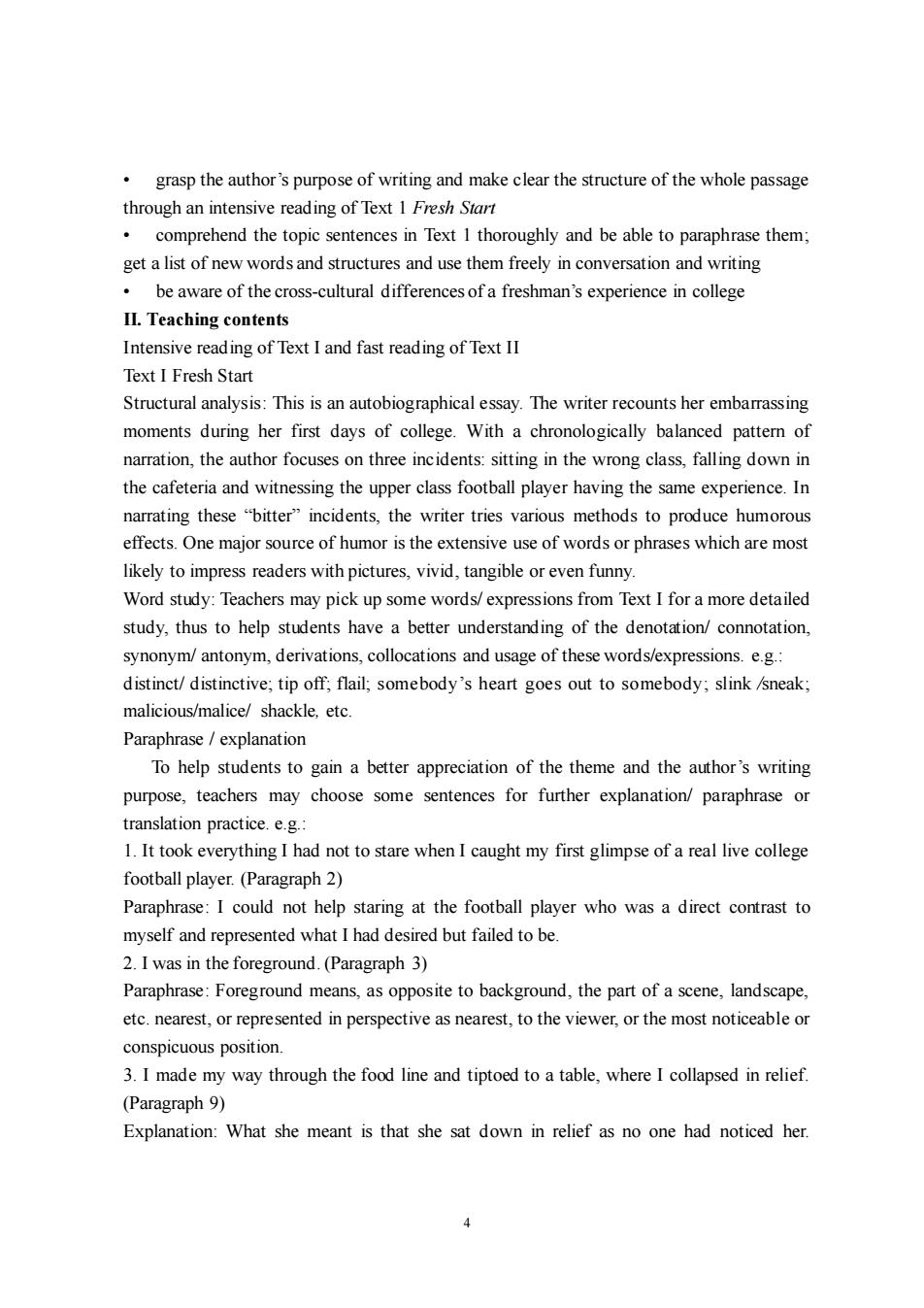
grasp the author's purpose of writing and make clear the structure of the whole passage through an intensive reading of Text 1 Fresh Start comprehend the topic sentences in Text 1 thoroughly and be able to paraphrase them: get a list of new words and structures and use them freely in conversation and writing be aware of the cross-cultural differences of a freshman's experience in college II.Teaching contents Intensive reading of Text I and fast reading of Text II Text I Fresh Start Structural analysis:This is an autobiographical essay.The writer recounts her embarrassing moments during her first days of college.With a chronologically balanced pattern of narration,the author focuses on three incidents:sitting in the wrong class,falling down in the cafeteria and witnessing the upper class football player having the same experience.In narrating these "bitter"incidents,the writer tries various methods to produce humorous effects.One major source of humor is the extensive use of words or phrases which are most likely to impress readers with pictures,vivid,tangible or even funny Word study:Teachers may pick up some words/expressions from Text I for a more detailed study.thus to help students have a better understanding of the denotation/connotation. synonym/antonym.derivations.collocations and usage of these words/expressions.e.g.: distinct/distinctive;tip off flail;somebody's heart goes out to somebody:slinksneak malicious/malice/shackle.etc. Paraphrase/explanation To help students to gain a better appreciation of the theme and the author's writing purpose,teachers may choose some sentences for further explanation/paraphrase or translation practice.e.g 1.It took everything I had not to stare when I caught my first glimpse of a real live college football player.(Paragraph 2) Paraphrase:I could not help staring at the football player who was a direct contrast to myself and represented what I had desired but failed to be. 2.I was in the foreground,(Paragraph 3) Paraphrase:Foreground means,as opposite to background,the part of a scene,landscape etc.nearest,or represented in perspective as nearest,to the viewer,or the most noticeable or conspicuous position. 3.I made my way through the food line and tiptoed to a table,where I collapsed in relief. (Paragraph 9) Explanation:What she meant is that she sat down in relief as no one had noticed her
4 • grasp the author’s purpose of writing and make clear the structure of the whole passage through an intensive reading of Text 1 Fresh Start • comprehend the topic sentences in Text 1 thoroughly and be able to paraphrase them; get a list of new words and structures and use them freely in conversation and writing • be aware of the cross-cultural differences of a freshman’s experience in college II. Teaching contents Intensive reading of Text I and fast reading of Text II Text I Fresh Start Structural analysis: This is an autobiographical essay. The writer recounts her embarrassing moments during her first days of college. With a chronologically balanced pattern of narration, the author focuses on three incidents: sitting in the wrong class, falling down in the cafeteria and witnessing the upper class football player having the same experience. In narrating these “bitter” incidents, the writer tries various methods to produce humorous effects. One major source of humor is the extensive use of words or phrases which are most likely to impress readers with pictures, vivid, tangible or even funny. Word study: Teachers may pick up some words/ expressions from Text I for a more detailed study, thus to help students have a better understanding of the denotation/ connotation, synonym/ antonym, derivations, collocations and usage of these words/expressions. e.g.: distinct/ distinctive; tip off; flail; somebody’s heart goes out to somebody; slink /sneak; malicious/malice/ shackle, etc. Paraphrase / explanation To help students to gain a better appreciation of the theme and the author’s writing purpose, teachers may choose some sentences for further explanation/ paraphrase or translation practice. e.g.: 1. It took everything I had not to stare when I caught my first glimpse of a real live college football player. (Paragraph 2) Paraphrase: I could not help staring at the football player who was a direct contrast to myself and represented what I had desired but failed to be. 2. I was in the foreground. (Paragraph 3) Paraphrase: Foreground means, as opposite to background, the part of a scene, landscape, etc. nearest, or represented in perspective as nearest, to the viewer, or the most noticeable or conspicuous position. 3. I made my way through the food line and tiptoed to a table, where I collapsed in relief. (Paragraph 9) Explanation: What she meant is that she sat down in relief as no one had noticed her
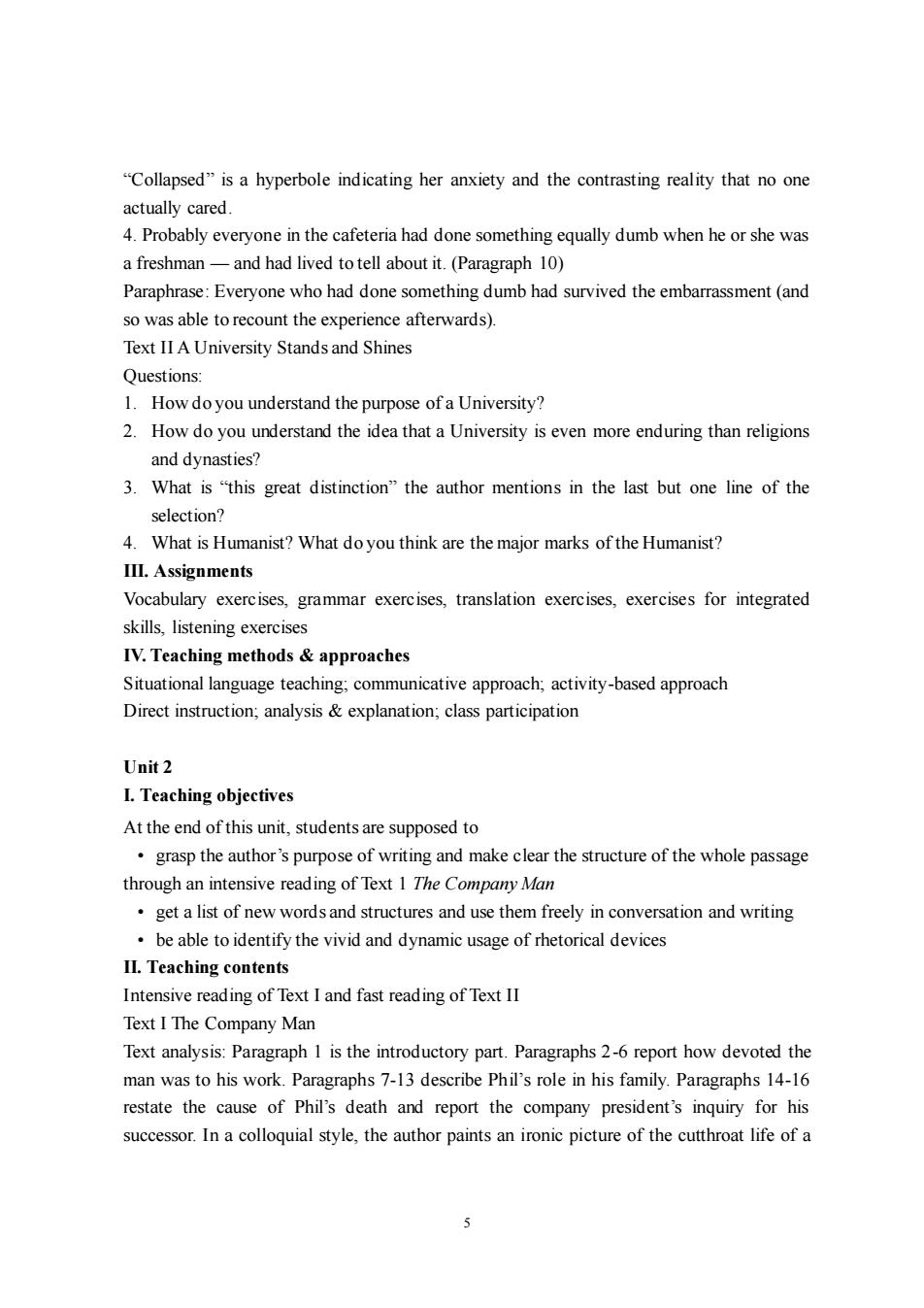
"Collapsed"is a hyperbole indicating her anxiety and the contrasting reality that no one actually cared 4.Probably everyone in the cafeteria had done something equally dumb when he or she was a freshman-and had lived to tell about it.(Paragraph 10) Paraphrase:Everyone who had done something dumb had survived the embarrassment(and so was able to recount the experience afterwards). Text IIA University Stands and Shines Questions: 1.How do you understand the purpose of a University? 2.How do you understand the idea that a University is even more enduring than religions and dynasties? 3.What is"this great distinction"the author mentions in the last but one line of the selection? 4.What is Humanist?What do you think are the major marks of the Humanist? III.Assignments Vocabulary exercises,grammar exercises,translation exercises,exercises for integrated skills,listening exercises IV.Teaching methods approaches Situational language teaching communicative approach,activity-based approach Direct instruction;analysis&explanation;class participation Unit 2 I.Teaching objectives At the end ofthis unit.students are supposed to grasp the author's purpose of writing and make clear the structure of the whole passage through an intensive reading of Text 1 The Company Man get a list of new words and structures and use them freely in conversation and writing be able to identify the vivid and dynamic usage of rhetorical devices II.Teaching contents Intensive reading of Text I and fast reading of Text II Text I The Company Man Text analysis:Paragraph 1 is the introductory part.Paragraphs 2-6 report how devoted the man was to his work Paragraphs7-13 describ hsoe in his family.Paragraphs 14-16 restate the cause of Phil's death and report the company president's inquiry for his successor.In a colloquial style,the author paints an ironic picture of the cutthroat life of a 5
5 “Collapsed” is a hyperbole indicating her anxiety and the contrasting reality that no one actually cared. 4. Probably everyone in the cafeteria had done something equally dumb when he or she was a freshman — and had lived to tell about it. (Paragraph 10) Paraphrase: Everyone who had done something dumb had survived the embarrassment (and so was able to recount the experience afterwards). Text II A University Stands and Shines Questions: 1. How do you understand the purpose of a University? 2. How do you understand the idea that a University is even more enduring than religions and dynasties? 3. What is “this great distinction” the author mentions in the last but one line of the selection? 4. What is Humanist? What do you think are the major marks of the Humanist? III. Assignments Vocabulary exercises, grammar exercises, translation exercises, exercises for integrated skills, listening exercises IV. Teaching methods & approaches Situational language teaching; communicative approach; activity-based approach Direct instruction; analysis & explanation; class participation Unit 2 I. Teaching objectives At the end of this unit, students are supposed to • grasp the author’s purpose of writing and make clear the structure of the whole passage through an intensive reading of Text 1 The Company Man • get a list of new words and structures and use them freely in conversation and writing • be able to identify the vivid and dynamic usage of rhetorical devices II. Teaching contents Intensive reading of Text I and fast reading of Text II Text I The Company Man Text analysis: Paragraph 1 is the introductory part. Paragraphs 2-6 report how devoted the man was to his work. Paragraphs 7-13 describe Phil’s role in his family. Paragraphs 14-16 restate the cause of Phil’s death and report the company president’s inquiry for his successor. In a colloquial style, the author paints an ironic picture of the cutthroat life of a
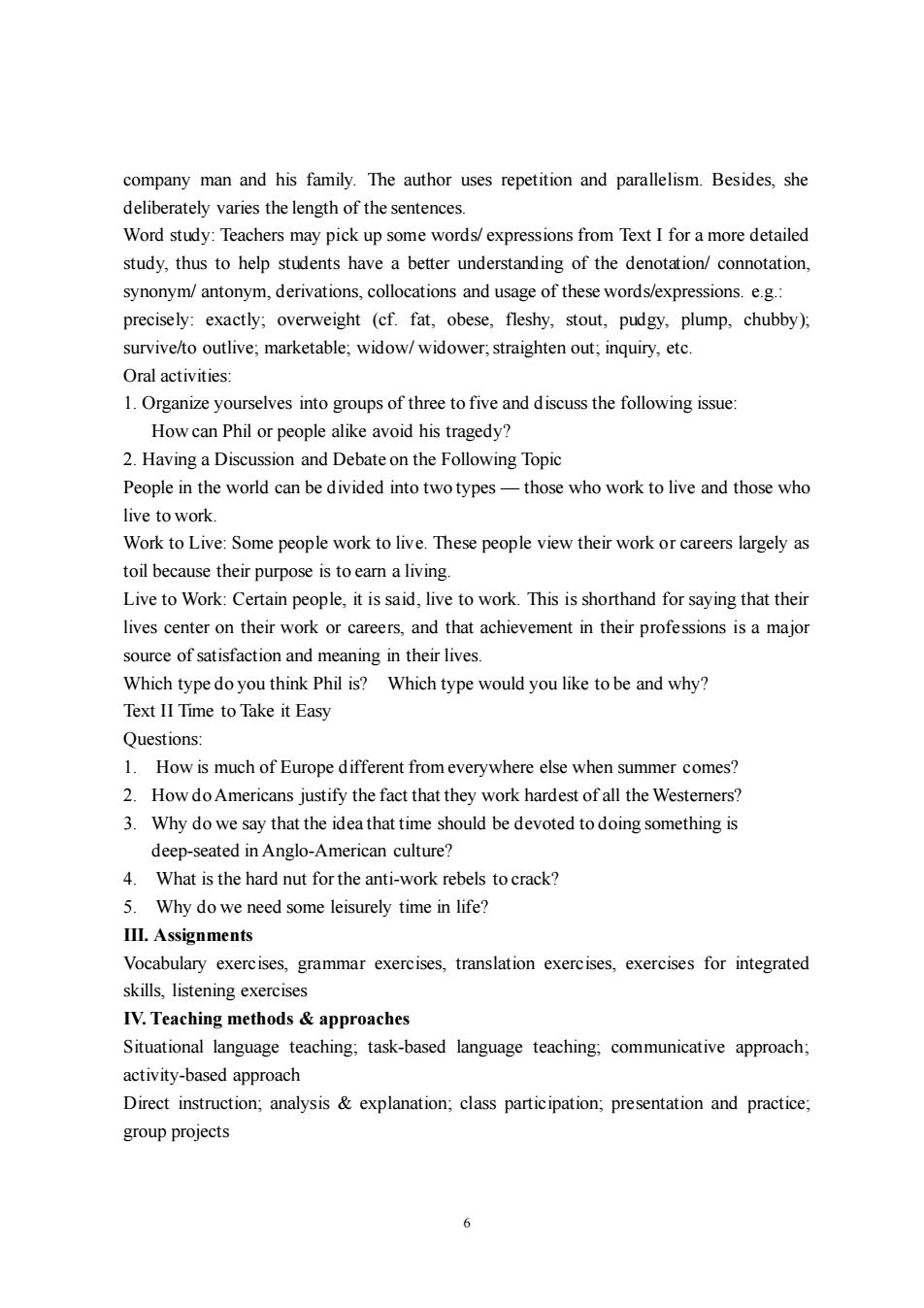
company man and his family.The author uses repetition and parallelism.Besides,she deliberately varies the length of the sentences. Word study:Teachers may pick up some words/expressions from Text I for a more detailed study,thus to help students have a better understanding of the denotation/connotation. synonym/antonym,derivations,collocations and usage of these words/expressions.e.g.: precisely:exactly;overweight (cf.fat,obese,fleshy,stout,pudgy,plump,chubby). survive/to outlive;marketable;widow/widower,straighten out;inquiry.etc. Oral activities: 1.Organize yourselves into groups of three to five and discuss the following issue How can Phil or people alike avoid his tragedy? 2.Having a Discussion and Debateon the Following Topic People in the world can be divided into two types-those who work to live and those who live to work. Work to Live:Some people work to live.These people view their work or careers largely as toil because their purpose is toeam a living. Live to Work:Certain people,it is said,live to work.This is shorthand for saying that their lives center on their work or careers,and that achievement in their professions is a majo source of satisfaction and meaning in their lives. Which typedo you think Phil is?Which type would you like to be and why? Text II Time to Take it Easy Questions 1.How is much of Europe different fromeverywhere else when summer comes? 2.How doAmericans justify the fact that they work hardest ofall the Westemers? 3.Why do we say that the idea that time should be devoted to doing something is deep-seated in Anglo-American culture? 4.What is the hard nut for the anti-work rebels to crack? 5.Why do we need some leisurely time in life? III.Assignments Vocabulary exercises,grammar exercises,translation exercises,exercises for integrated skills,listening exercises TV.Teaching methods approaches Situational language teaching task-based language teaching communicative approach. activity-based approach Direct instruction;analysis explanation:class participation;presentation and practice group projects 6
6 company man and his family. The author uses repetition and parallelism. Besides, she deliberately varies the length of the sentences. Word study: Teachers may pick up some words/ expressions from Text I for a more detailed study, thus to help students have a better understanding of the denotation/ connotation, synonym/ antonym, derivations, collocations and usage of these words/expressions. e.g.: precisely: exactly; overweight (cf. fat, obese, fleshy, stout, pudgy, plump, chubby); survive/to outlive; marketable; widow/ widower; straighten out; inquiry, etc. Oral activities: 1. Organize yourselves into groups of three to five and discuss the following issue: How can Phil or people alike avoid his tragedy? 2. Having a Discussion and Debate on the Following Topic People in the world can be divided into two types — those who work to live and those who live to work. Work to Live: Some people work to live. These people view their work or careers largely as toil because their purpose is to earn a living. Live to Work: Certain people, it is said, live to work. This is shorthand for saying that their lives center on their work or careers, and that achievement in their professions is a major source of satisfaction and meaning in their lives. Which type do you think Phil is? Which type would you like to be and why? Text II Time to Take it Easy Questions: 1. How is much of Europe different from everywhere else when summer comes? 2. How do Americans justify the fact that they work hardest of all the Westerners? 3. Why do we say that the idea that time should be devoted to doing something is deep-seated in Anglo-American culture? 4. What is the hard nut for the anti-work rebels to crack? 5. Why do we need some leisurely time in life? III. Assignments Vocabulary exercises, grammar exercises, translation exercises, exercises for integrated skills, listening exercises IV. Teaching methods & approaches Situational language teaching; task-based language teaching; communicative approach; activity-based approach Direct instruction; analysis & explanation; class participation; presentation and practice; group projects
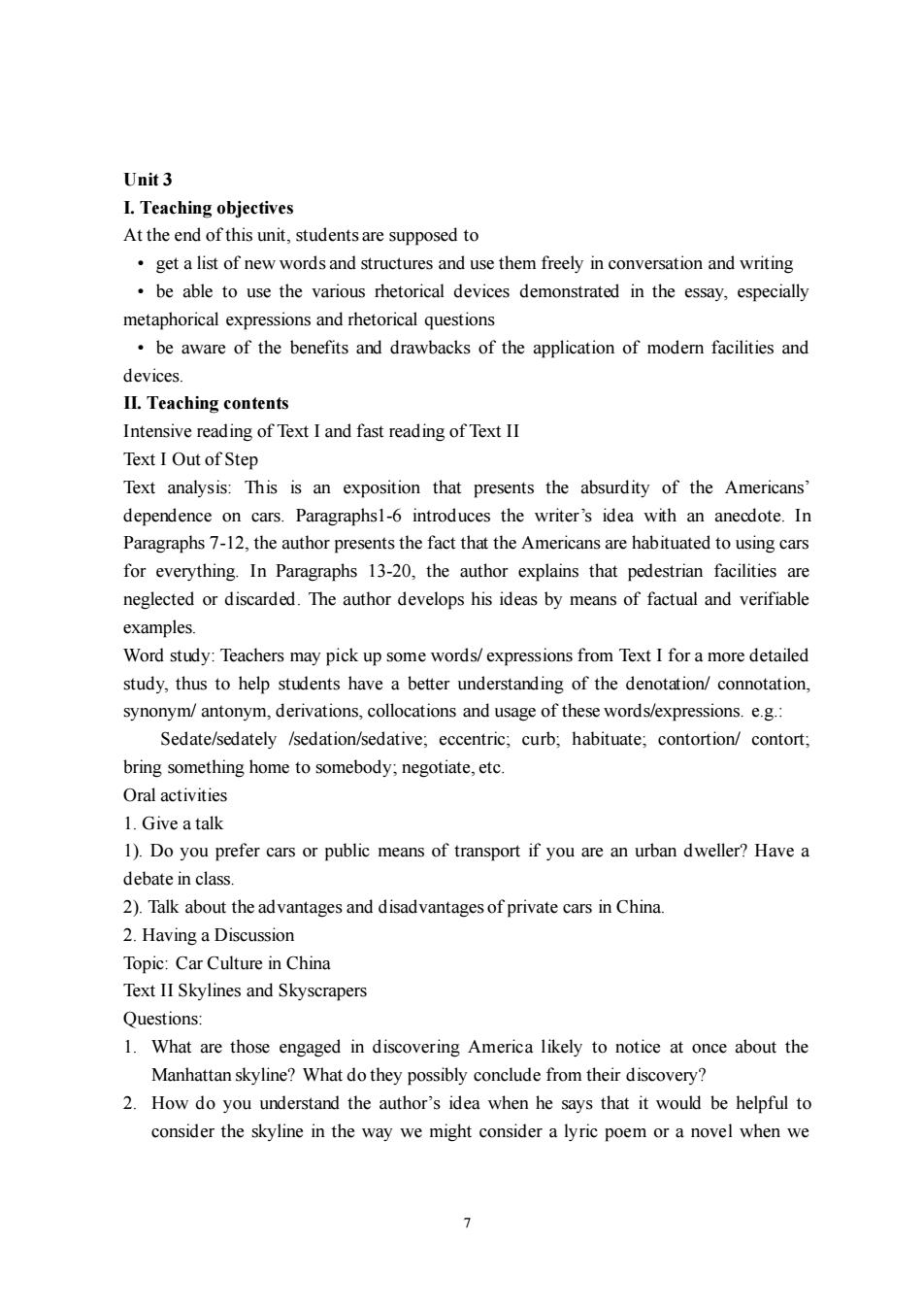
Unit3 I.Teaching objectives At the end of this unit,studentsare supposed to get a list of new words and structures and use them freely in conversation and writing be able to use the various rhetorical devices demonstrated in the essay,especially metaphorical expressions and rhetorical questions be aware of the benefits and drawbacks of the application of modem facilities and devices. II.Teaching contents Intensive reading of Text I and fast reading of Text II Text I Out of Step Text analysis:This is an exposition that presents the absurdity of the Americans' dependence on cars.introduces the writer's idea with an anecdote.In Paragraphs 7-12,the author presents the fact that the Americans are habituated to using cars for everything.In Paragraphs 13-20,the author explains that pedestrian facilities are neglected or discarded.The author develops his ideas by means of factual and verifiable examples. Word study:Teachers may pick up some words/expressions from Text I for a more detailed study,thus to help students have a better understanding of the denotation/connotation synonym/antonym,derivations,collocations and usage of these words/expressions.e.g.: Sedate/sedately /sedation/sedative::habituate:contortion/contort bring something home to somebody;negotiate,etc. Oral activities 1.Give a talk 1).Do you prefer cars or public means of transport if you are an urban dweller?Have a debate in class 2).Talk about the advantages and disadvantagesof private cars in China 2.Having a Discussion Topic:Car Culture in China Text II Skylines and Skyscrapers Questions: 1.What are those engaged in discovering America likely to notice at once about the Manhattan skyline?What do they possibly conclude from their discovery? 2.How do you understand the author's idea when he says that it would be helpful to consider the skyline in the way we might consider a lyric poem or a novel when we 7
7 Unit 3 I. Teaching objectives At the end of this unit, students are supposed to • get a list of new words and structures and use them freely in conversation and writing • be able to use the various rhetorical devices demonstrated in the essay, especially metaphorical expressions and rhetorical questions • be aware of the benefits and drawbacks of the application of modern facilities and devices. II. Teaching contents Intensive reading of Text I and fast reading of Text II Text I Out of Step Text analysis: This is an exposition that presents the absurdity of the Americans’ dependence on cars. Paragraphs1-6 introduces the writer’s idea with an anecdote. In Paragraphs 7-12, the author presents the fact that the Americans are habituated to using cars for everything. In Paragraphs 13-20, the author explains that pedestrian facilities are neglected or discarded. The author develops his ideas by means of factual and verifiable examples. Word study: Teachers may pick up some words/ expressions from Text I for a more detailed study, thus to help students have a better understanding of the denotation/ connotation, synonym/ antonym, derivations, collocations and usage of these words/expressions. e.g.: Sedate/sedately /sedation/sedative; eccentric; curb; habituate; contortion/ contort; bring something home to somebody; negotiate, etc. Oral activities 1. Give a talk 1). Do you prefer cars or public means of transport if you are an urban dweller? Have a debate in class. 2). Talk about the advantages and disadvantages of private cars in China. 2. Having a Discussion Topic: Car Culture in China Text II Skylines and Skyscrapers Questions: 1. What are those engaged in discovering America likely to notice at once about the Manhattan skyline? What do they possibly conclude from their discovery? 2. How do you understand the author’s idea when he says that it would be helpful to consider the skyline in the way we might consider a lyric poem or a novel when we

analyze its aesthetic quality? 3.How could the fluid and ever-changing unity be achieved? III.Assignments Vocabulary exercises,grammar exercises,translation exercises,exercises for integrated skills,listening exercises IV.Teaching methods approaches Situational language teaching:task-based language teaching:communicative approach: activity-based approach Analysis&explanation;presentation and practice;group projects,review;in-class test& assessment Unit4 I.Teaching objectives At the end of this unit,students are supposed to be able to use the various rhetorical devices demonstrated in the essay,especially metaphorical expressions and rhetorical questions get a list of new wordsand structures and use them freely in conversation and writing grasp the author's purpose of writing and the theme of the essay II.Teaching contents Intensive reading of Text I and fast reading of Text II Text I Fun,Oh Boy.Fun.You could die from it Text analysis This essay evaluates the "fun"side of the American culture in an ironic way. Paragraphs 1-5 are the introductory part,which provide a simulative definition of"fun." Paragraphs 6-11 are the main body in which the writer gives an extended definition of it by negation.Paragraphs 12-15 are the concluding part with an anecdote that further explains what fun is. Todevelop the definition,a number of methods have been employed,among which are narration,comparison and contrast.The effective use of repetition adds a lot to the essay's strength. Word study: Teachers may pick up some words/expressions from Text I for a more detailed study thus to help students have a better understanding of the denotation/connotation,synonym/ antonym,derivations,collocations and usage of these words/expressions.e.g. Overshadow;flunk;epitome;epitomize;damper,blaspheme/to swear,scan/examine/
8 analyze its aesthetic quality? 3. How could the fluid and ever-changing unity be achieved? III. Assignments Vocabulary exercises, grammar exercises, translation exercises, exercises for integrated skills, listening exercises IV. Teaching methods & approaches Situational language teaching; task-based language teaching; communicative approach; activity-based approach Analysis & explanation; presentation and practice; group projects; review; in-class test & assessment Unit 4 I. Teaching objectives At the end of this unit, students are supposed to • be able to use the various rhetorical devices demonstrated in the essay, especially metaphorical expressions and rhetorical questions • get a list of new words and structures and use them freely in conversation and writing • grasp the author’s purpose of writing and the theme of the essay II. Teaching contents Intensive reading of Text I and fast reading of Text II Text I Fun, Oh Boy. Fun. You could die from it. Text analysis This essay evaluates the “fun” side of the American culture in an ironic way. Paragraphs 1-5 are the introductory part, which provide a simulative definition of “fun.” Paragraphs 6-11 are the main body in which the writer gives an extended definition of it by negation. Paragraphs 12-15 are the concluding part with an anecdote that further explains what fun is. To develop the definition, a number of methods have been employed, among which are narration, comparison and contrast. The effective use of repetition adds a lot to the essay’s strength. Word study: Teachers may pick up some words/ expressions from Text I for a more detailed study, thus to help students have a better understanding of the denotation/ connotation, synonym/ antonym, derivations, collocations and usage of these words/expressions. e.g.: Overshadow; flunk; epitome; epitomize; damper; blaspheme/to swear; scan/examine/
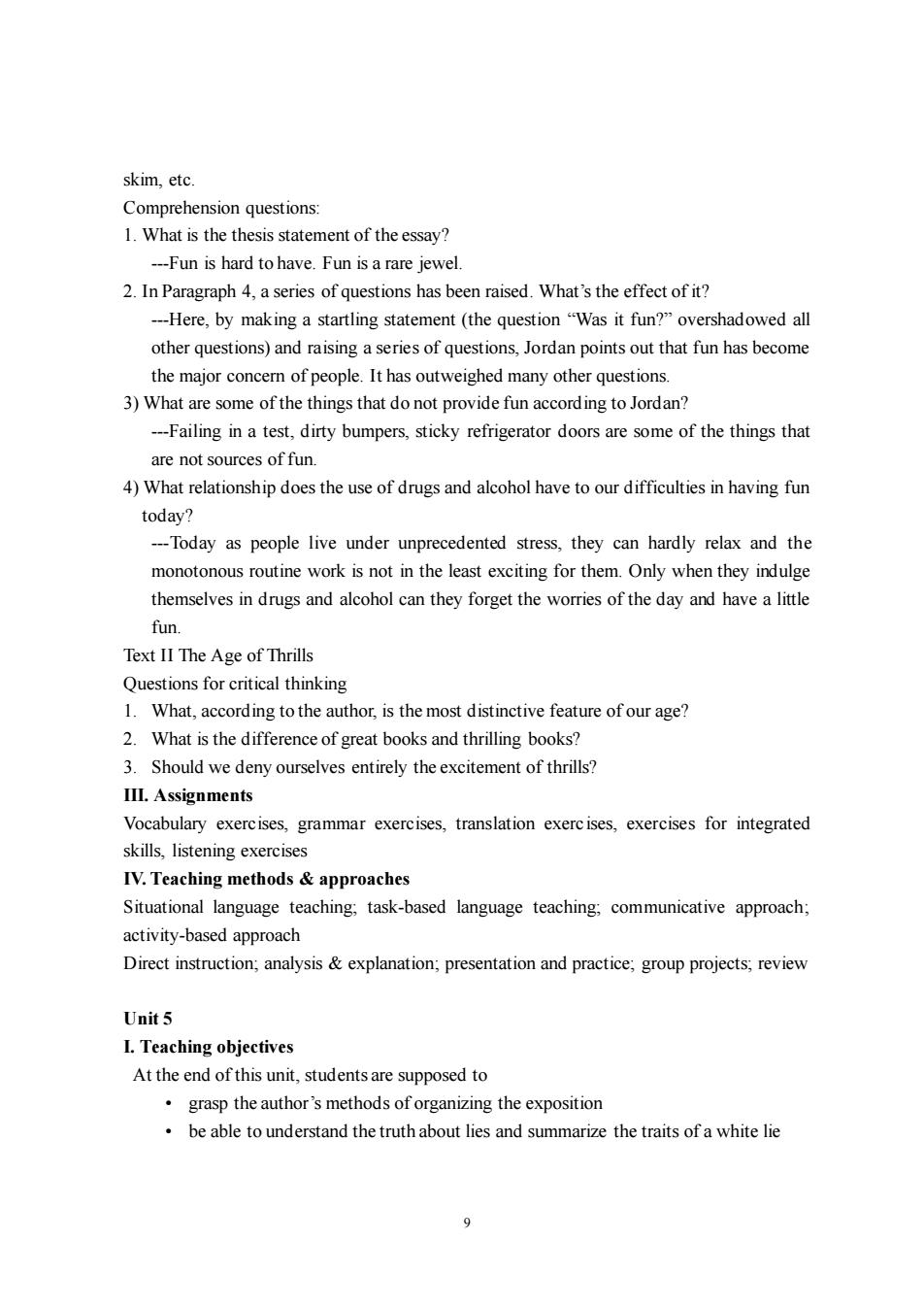
skim,etc. Comprehension questions: 1.What is the thesis statement of the essay? --Fun is hard to have.Fun is a rare jewel. 2.In Paragraph 4.a series of questions has been raised.What's the effect of it? ---Here,by making a startling statement(the question"Was it fun?"overshadowed all other questions)and raising a series of questions.Jordan points out that fun has become the major concern of people.It has outweighed many other questions. 3)What are some of the things that do not provide fun according to Jordan? ---Failing in a test,dirty bumpers,sticky refrigerator doors are some of the things that are not sources of fun. 4)What relationship does the use of drugs and alcohol have to our difficulties in having fun today? ---Today as people live under unprecedented stress,they can hardly relax and the monotonous routine work is not in the least exciting for them.Only when they indulge themselves in drugs and alcohol can they forget the worries of the day and have a little fun. Text II The Age of Thrills Questions for critical thinking 1.What,according to the author,is the most distinctive feature of our age? 2.What is the difference of great books and thrilling books? 3.Should we deny ourselves entirely the excitement of thrills? III.Assignments Vocabulary exercises,grammar exercises,translation exercises,exercises for integrated skills,listening exercises IV.Teaching methods approaches Situational language teaching:task-based language teaching:communicative approach; activity-based approach Direct instruction,analysis&explanation;presentation and practice;group projects;review Unit5 I.Teaching objectives At the end of this unit,students are supposed to grasp the author's methods of organizing the exposition be able to understand the truth about lies and summarize the traits of a white lie 9
9 skim, etc. Comprehension questions: 1. What is the thesis statement of the essay? ---Fun is hard to have. Fun is a rare jewel. 2. In Paragraph 4, a series of questions has been raised. What’s the effect of it? ---Here, by making a startling statement (the question “Was it fun?” overshadowed all other questions) and raising a series of questions, Jordan points out that fun has become the major concern of people. It has outweighed many other questions. 3) What are some of the things that do not provide fun according to Jordan? ---Failing in a test, dirty bumpers, sticky refrigerator doors are some of the things that are not sources of fun. 4) What relationship does the use of drugs and alcohol have to our difficulties in having fun today? ---Today as people live under unprecedented stress, they can hardly relax and the monotonous routine work is not in the least exciting for them. Only when they indulge themselves in drugs and alcohol can they forget the worries of the day and have a little fun. Text II The Age of Thrills Questions for critical thinking 1. What, according to the author, is the most distinctive feature of our age? 2. What is the difference of great books and thrilling books? 3. Should we deny ourselves entirely the excitement of thrills? III. Assignments Vocabulary exercises, grammar exercises, translation exercises, exercises for integrated skills, listening exercises IV. Teaching methods & approaches Situational language teaching; task-based language teaching; communicative approach; activity-based approach Direct instruction; analysis & explanation; presentation and practice; group projects; review Unit 5 I. Teaching objectives At the end of this unit, students are supposed to • grasp the author’s methods of organizing the exposition • be able to understand the truth about lies and summarize the traits of a white lie
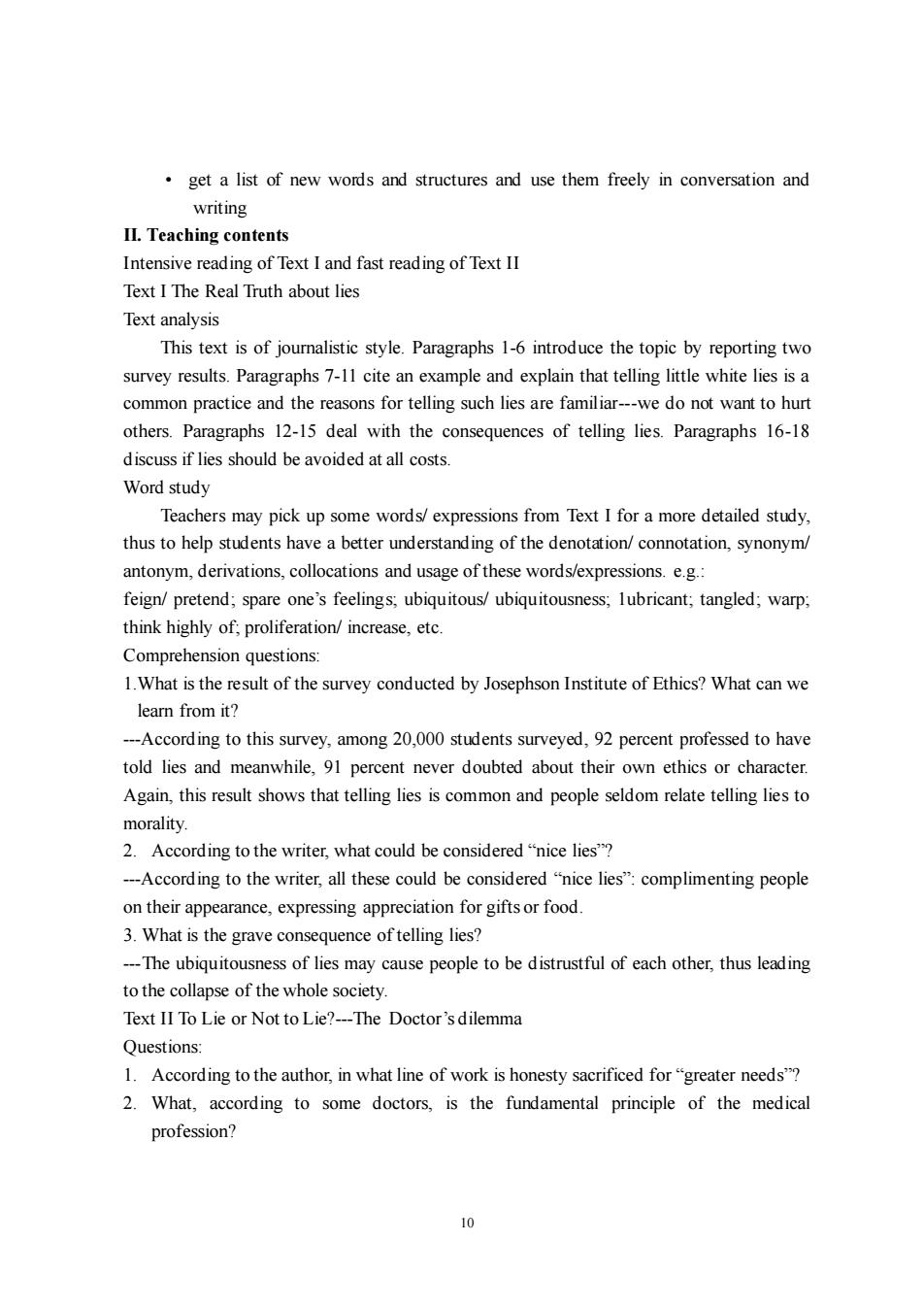
get a list of new words and structures and use them freely in conversation and writing II.Teaching contents Intensive reading of Text I and fast reading of Text II Text I The Real Truth about lies Text analysis This text is of joumalistic style.Paragraphs 1-6 introduce the topic by reporting two survey results.Paragraphs 7-11 cite an example and explain that telling little white lies is a common practice and the reasons for telling such lies are familiar--we do not want to hurt others.Paragraphs 12-15 deal with the consequences of telling lies.Paragraphs 16-18 discuss if lies should be avoided at all costs. Word study Teachers may pick up some words/expressions from Text I for a more detailed study. thus to help students have a better understanding of the denotation/connotation,synonym/ antonym,derivations,collocations and usage of these words/expressions.e.g. feign/pretend;spare one's feelings;ubiquitous/ubiquitousness;lubricant;tangled;warp: think highly of proliferation/increase,etc Comprehension questions: .What is the result of the survey conducted by Josephson Institute of Ethics?What can we learn from it? -According to this survey.among 20,000 students surveyed,92 percent professed to have told lies and meanwhile,91 percent never doubted about their own ethics or character. Again,this result shows that telling lies is common and people seldom relate telling lies to morality. 2.According to the writer,what could be considered"nice lies"? --According to the writer,all these could be considered"nice lies":complimenting people on their appearance,expressing appreciation for gifts or food 3.What is the grave consequence oftelling lies? ---The ubiquitousness of lies may cause people to be distrustful of each other,thus leading to the collapse of the whole society. Text II To Lie or Not to Lie?--The Doctor'sdilemma Questions: 1.According to the author,in what line of work is honesty sacrificed for"greater needs"? 2.What,according to some doctors.is the fundamental principle of the medical profession? 10
10 • get a list of new words and structures and use them freely in conversation and writing II. Teaching contents Intensive reading of Text I and fast reading of Text II Text I The Real Truth about lies Text analysis This text is of journalistic style. Paragraphs 1-6 introduce the topic by reporting two survey results. Paragraphs 7-11 cite an example and explain that telling little white lies is a common practice and the reasons for telling such lies are familiar---we do not want to hurt others. Paragraphs 12-15 deal with the consequences of telling lies. Paragraphs 16-18 discuss if lies should be avoided at all costs. Word study Teachers may pick up some words/ expressions from Text I for a more detailed study, thus to help students have a better understanding of the denotation/ connotation, synonym/ antonym, derivations, collocations and usage of these words/expressions. e.g.: feign/ pretend; spare one’s feelings; ubiquitous/ ubiquitousness; 1ubricant; tangled; warp; think highly of; proliferation/ increase, etc. Comprehension questions: 1.What is the result of the survey conducted by Josephson Institute of Ethics? What can we learn from it? ---According to this survey, among 20,000 students surveyed, 92 percent professed to have told lies and meanwhile, 91 percent never doubted about their own ethics or character. Again, this result shows that telling lies is common and people seldom relate telling lies to morality. 2. According to the writer, what could be considered “nice lies”? ---According to the writer, all these could be considered “nice lies”: complimenting people on their appearance, expressing appreciation for gifts or food. 3. What is the grave consequence of telling lies? ---The ubiquitousness of lies may cause people to be distrustful of each other, thus leading to the collapse of the whole society. Text II To Lie or Not to Lie?---The Doctor’s dilemma Questions: 1. According to the author, in what line of work is honesty sacrificed for “greater needs”? 2. What, according to some doctors, is the fundamental principle of the medical profession?